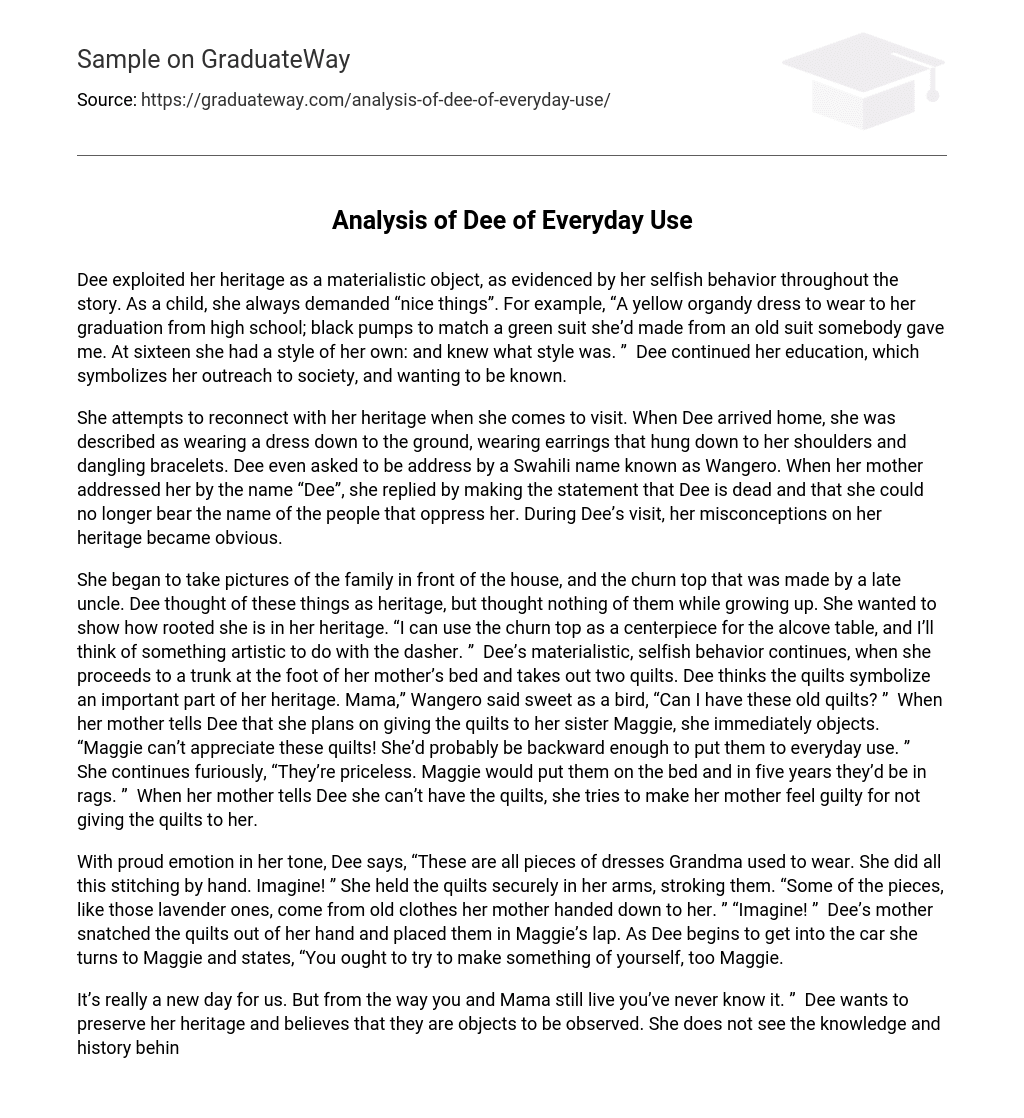Dee exploited her heritage as a materialistic object, as evidenced by her selfish behavior throughout the story. As a child, she always demanded “nice things”. For example, “A yellow organdy dress to wear to her graduation from high school; black pumps to match a green suit she’d made from an old suit somebody gave me. At sixteen she had a style of her own: and knew what style was. ” Dee continued her education, which symbolizes her outreach to society, and wanting to be known.
She attempts to reconnect with her heritage when she comes to visit. When Dee arrived home, she was described as wearing a dress down to the ground, wearing earrings that hung down to her shoulders and dangling bracelets. Dee even asked to be address by a Swahili name known as Wangero. When her mother addressed her by the name “Dee”, she replied by making the statement that Dee is dead and that she could no longer bear the name of the people that oppress her. During Dee’s visit, her misconceptions on her heritage became obvious.
She began to take pictures of the family in front of the house, and the churn top that was made by a late uncle. Dee thought of these things as heritage, but thought nothing of them while growing up. She wanted to show how rooted she is in her heritage. “I can use the churn top as a centerpiece for the alcove table, and I’ll think of something artistic to do with the dasher. ” Dee’s materialistic, selfish behavior continues, when she proceeds to a trunk at the foot of her mother’s bed and takes out two quilts. Dee thinks the quilts symbolize an important part of her heritage. Mama,” Wangero said sweet as a bird, “Can I have these old quilts? ” When her mother tells Dee that she plans on giving the quilts to her sister Maggie, she immediately objects. “Maggie can’t appreciate these quilts! She’d probably be backward enough to put them to everyday use. ” She continues furiously, “They’re priceless. Maggie would put them on the bed and in five years they’d be in rags. ” When her mother tells Dee she can’t have the quilts, she tries to make her mother feel guilty for not giving the quilts to her.
With proud emotion in her tone, Dee says, “These are all pieces of dresses Grandma used to wear. She did all this stitching by hand. Imagine! ” She held the quilts securely in her arms, stroking them. “Some of the pieces, like those lavender ones, come from old clothes her mother handed down to her. ” “Imagine! ” Dee’s mother snatched the quilts out of her hand and placed them in Maggie’s lap. As Dee begins to get into the car she turns to Maggie and states, “You ought to try to make something of yourself, too Maggie.
It’s really a new day for us. But from the way you and Mama still live you’ve never know it. ” Dee wants to preserve her heritage and believes that they are objects to be observed. She does not see the knowledge and history behind the items. She only sees the items as materialistic things that can one day be destroyed.
Works Cited
- Kennedy, X. J. , and Dana Gioia. Literature: An Introduction to Fiction, Poetry, Drama, and Writing. 10th ed. New York: PEARSON LONGMAN, 2007. Print.





